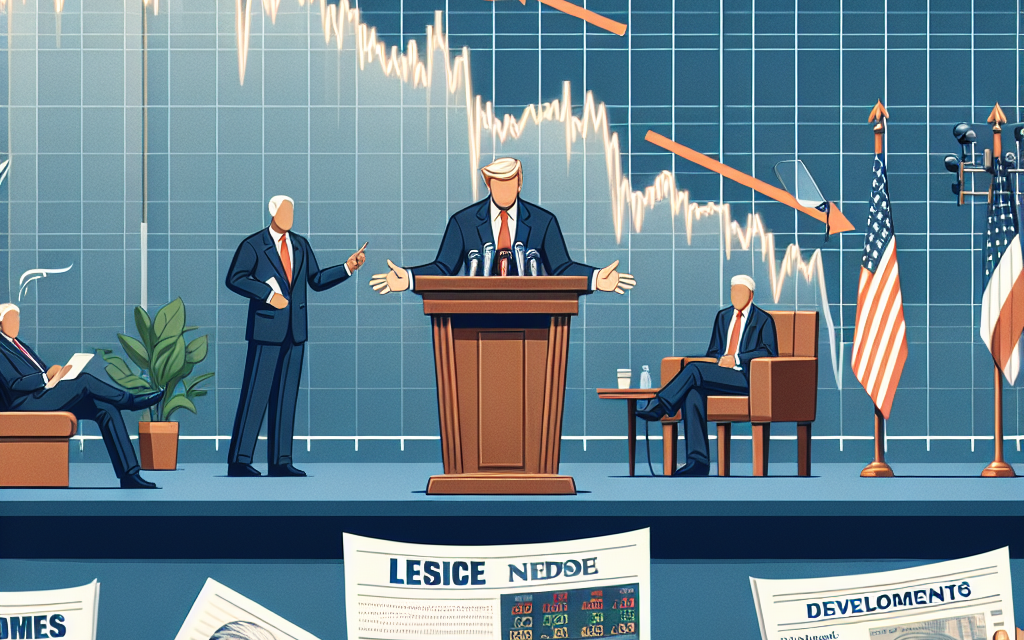“Market Shifts: S&P 500 and Nasdaq Tumble as Powell Speaks and Trump Headlines Stir”
Introduction
In recent market developments, the S&P 500 and Nasdaq indices have experienced notable declines, influenced by a combination of economic and political factors. Federal Reserve Chair Jerome Powell’s latest speech has injected uncertainty into the financial markets, as investors closely analyze his remarks for insights into future monetary policy directions. Concurrently, developments surrounding former President Donald Trump have added another layer of complexity, impacting investor sentiment and market dynamics. These events underscore the intricate interplay between economic policy and political events, shaping the current landscape of U.S. financial markets.
Impact Of Powell’s Speech On S&P 500 And Nasdaq
In recent developments, the financial markets have been closely monitoring the movements of the S&P 500 and Nasdaq, particularly in light of Federal Reserve Chair Jerome Powell’s recent speech and unfolding events surrounding former President Donald Trump. These factors have contributed to a decline in both indices, reflecting investor sentiment and market volatility. Powell’s speech, delivered at a key economic symposium, emphasized the Federal Reserve’s commitment to managing inflation while supporting economic growth. His remarks underscored the challenges of balancing these dual objectives, especially in an environment marked by persistent inflationary pressures. Investors, already on edge due to economic uncertainties, reacted to Powell’s cautious tone, which suggested that interest rates might remain elevated for a longer period than previously anticipated. This prospect of prolonged higher rates has raised concerns about borrowing costs and their potential impact on corporate profits, leading to a sell-off in equities.
The S&P 500, a broad measure of the U.S. stock market, experienced a notable decline as investors digested Powell’s comments. The index, which includes a diverse range of sectors, saw particular weakness in interest rate-sensitive industries such as technology and consumer discretionary. These sectors, often reliant on low borrowing costs to fuel growth, are vulnerable to the implications of sustained higher interest rates. Consequently, the S&P 500’s decline reflects a broader apprehension about the economic outlook and the potential for slower growth in the coming months.
Similarly, the Nasdaq Composite, heavily weighted towards technology stocks, also faced downward pressure. The tech sector, which has been a significant driver of market gains in recent years, is particularly sensitive to changes in interest rates. Higher rates can increase the cost of capital for tech companies, many of which rely on borrowing to finance innovation and expansion. As a result, Powell’s speech has prompted a reassessment of valuations within the tech sector, contributing to the Nasdaq’s decline.
In addition to Powell’s speech, developments surrounding former President Donald Trump have added another layer of complexity to the market landscape. Legal proceedings and political uncertainties related to Trump have created an environment of heightened unpredictability. Investors are wary of potential disruptions that could arise from these developments, particularly if they lead to broader political or economic ramifications. This uncertainty has further fueled market volatility, as participants grapple with the implications of these events on the investment climate.
Moreover, the combination of Powell’s remarks and the Trump-related developments has amplified existing concerns about the global economic environment. Geopolitical tensions, supply chain disruptions, and ongoing pandemic-related challenges continue to weigh on investor sentiment. In this context, the declines in the S&P 500 and Nasdaq can be seen as a reflection of broader anxieties about the future trajectory of the economy and financial markets.
In conclusion, the recent declines in the S&P 500 and Nasdaq underscore the complex interplay of factors influencing market dynamics. Powell’s speech, with its implications for interest rates and economic growth, has been a key driver of recent market movements. At the same time, developments related to former President Trump have added an additional layer of uncertainty. As investors navigate this challenging landscape, the focus remains on assessing the potential impacts of these factors on corporate earnings, economic growth, and overall market stability.
Analyzing The Market Reaction To Trump’s Latest Developments
In recent days, the financial markets have been closely monitoring a series of developments that have significantly impacted investor sentiment. Notably, the S&P 500 and Nasdaq indices have experienced declines, largely influenced by Federal Reserve Chair Jerome Powell’s recent speech and unfolding events related to former President Donald Trump. These factors have combined to create a complex landscape for market participants, prompting a reassessment of risk and opportunity.
Jerome Powell’s speech, delivered at a key economic symposium, was eagerly anticipated by investors seeking clarity on the Federal Reserve’s monetary policy trajectory. Powell’s remarks underscored the central bank’s commitment to combating inflation, signaling the possibility of further interest rate hikes. This hawkish stance, while aimed at stabilizing prices, has raised concerns about the potential dampening effect on economic growth. Consequently, investors have reacted by recalibrating their portfolios, leading to a sell-off in equities, particularly in technology stocks that are sensitive to interest rate fluctuations. The Nasdaq, heavily weighted with tech companies, has been notably affected, reflecting the broader apprehension about the sector’s future earnings potential in a higher-rate environment.
Simultaneously, developments surrounding Donald Trump have added another layer of complexity to the market’s outlook. Recent legal proceedings and investigations involving the former president have captured public and investor attention. While the direct economic implications of these developments are not immediately clear, the political uncertainty they introduce can influence market dynamics. Investors often react to political instability by seeking safer assets, which can lead to volatility in equity markets. The S&P 500, a broad measure of the market, has not been immune to these pressures, as traders weigh the potential for prolonged political drama against the backdrop of an already uncertain economic environment.
Moreover, the interplay between Powell’s policy signals and Trump’s legal challenges highlights the multifaceted nature of market reactions. On one hand, the prospect of tighter monetary policy could slow economic momentum, affecting corporate profits and consumer spending. On the other hand, political developments can shift focus away from economic fundamentals, creating a climate of unpredictability. This duality underscores the importance of a nuanced approach to market analysis, where investors must consider both macroeconomic indicators and geopolitical events.
In light of these factors, market participants are adopting a cautious stance, with many opting to diversify their holdings to mitigate risk. The recent declines in the S&P 500 and Nasdaq serve as a reminder of the inherent volatility in financial markets, particularly during periods of heightened uncertainty. As investors navigate this challenging landscape, they are likely to pay close attention to upcoming economic data releases and any further developments in the political arena. These elements will be crucial in shaping market expectations and guiding investment strategies in the coming weeks.
In conclusion, the recent declines in the S&P 500 and Nasdaq can be attributed to a confluence of factors, including Jerome Powell’s hawkish monetary policy signals and the ongoing legal challenges facing Donald Trump. As these events continue to unfold, they will undoubtedly influence investor sentiment and market dynamics. By maintaining a vigilant approach and considering both economic and political developments, investors can better position themselves to navigate the complexities of the current market environment.
S&P 500 And Nasdaq: Key Factors Behind The Recent Decline
The recent decline in the S&P 500 and Nasdaq indices has captured the attention of investors and analysts alike, as a confluence of factors has contributed to this downturn. Central to this development is the speech delivered by Federal Reserve Chairman Jerome Powell, which has had a significant impact on market sentiment. Powell’s remarks, which emphasized the need for continued vigilance in combating inflation, have led to increased speculation about the future trajectory of interest rates. As a result, investors are recalibrating their expectations, leading to heightened volatility in the equity markets.
Powell’s speech underscored the Federal Reserve’s commitment to its dual mandate of promoting maximum employment and maintaining price stability. However, his comments suggested that the path to achieving these goals may involve further interest rate hikes, a prospect that has unsettled investors. The anticipation of higher borrowing costs has raised concerns about the potential dampening effect on economic growth and corporate profitability. Consequently, sectors that are particularly sensitive to interest rate fluctuations, such as technology and consumer discretionary, have experienced notable declines.
In addition to Powell’s speech, developments surrounding former President Donald Trump have also played a role in shaping market dynamics. Recent legal proceedings and investigations involving Trump have introduced an element of political uncertainty, which has historically been a source of market volatility. Investors are closely monitoring these developments, as any significant political upheaval could have far-reaching implications for fiscal policy and regulatory frameworks. The potential for increased political risk has added another layer of complexity to the already challenging investment landscape.
Moreover, the broader macroeconomic environment continues to exert pressure on the markets. Persistent supply chain disruptions, coupled with geopolitical tensions, have contributed to inflationary pressures that are proving to be more persistent than initially anticipated. This has led to concerns about the sustainability of corporate earnings growth, as companies grapple with rising input costs and potential disruptions to their operations. The interplay between these macroeconomic factors and the Federal Reserve’s policy stance is creating a challenging backdrop for investors seeking to navigate the current market environment.
Despite these headwinds, it is important to recognize that the recent decline in the S&P 500 and Nasdaq is not entirely unexpected. Markets have experienced a prolonged period of robust gains, driven in part by accommodative monetary policy and fiscal stimulus measures. As the economy transitions to a more normalized state, some degree of market correction is to be anticipated. Investors are now tasked with reassessing their portfolios and strategies in light of the evolving economic landscape.
In conclusion, the recent decline in the S&P 500 and Nasdaq can be attributed to a combination of factors, including Powell’s speech, political developments involving Trump, and broader macroeconomic challenges. While these elements have introduced a degree of uncertainty and volatility, they also underscore the importance of maintaining a long-term perspective. As markets continue to adjust to changing conditions, investors are encouraged to remain vigilant and adaptable, recognizing that periods of volatility can also present opportunities for those who are well-prepared. By staying informed and maintaining a disciplined approach, investors can navigate the complexities of the current market environment and position themselves for future success.
Investor Sentiment: How Powell’s Remarks Are Shaping The Market

Investor sentiment is a crucial factor in the financial markets, often swaying the direction of indices like the S&P 500 and Nasdaq. Recently, the markets have been particularly sensitive to remarks from influential figures such as Federal Reserve Chair Jerome Powell. His latest speech has had a noticeable impact, contributing to a decline in both the S&P 500 and Nasdaq. Powell’s comments, which focused on the Federal Reserve’s monetary policy and economic outlook, have left investors grappling with uncertainty. As he reiterated the Fed’s commitment to controlling inflation, he also hinted at the possibility of future interest rate hikes. This prospect of tighter monetary policy has led to increased caution among investors, who are wary of the potential impact on economic growth and corporate earnings.
In addition to Powell’s remarks, developments surrounding former President Donald Trump have also played a role in shaping market sentiment. Legal challenges and political controversies involving Trump have created an additional layer of uncertainty. Investors are concerned about the potential implications for regulatory policies and the broader political landscape. This uncertainty has contributed to a risk-averse environment, prompting some investors to pull back from equities and seek safer assets.
The combination of Powell’s speech and the Trump-related developments has led to a decline in investor confidence, which is reflected in the performance of the S&P 500 and Nasdaq. Both indices have experienced downward pressure as market participants reassess their risk exposure. The technology sector, which is heavily represented in the Nasdaq, has been particularly affected. Tech stocks are often sensitive to interest rate changes due to their reliance on future growth prospects. As a result, the possibility of higher rates has led to a reevaluation of valuations within the sector.
Moreover, the broader economic context cannot be ignored. Inflationary pressures continue to be a concern, with rising prices affecting consumer spending and corporate profit margins. Supply chain disruptions and labor market challenges further complicate the economic landscape. These factors, combined with the potential for tighter monetary policy, have created a challenging environment for investors to navigate.
Despite these headwinds, it is important to note that market sentiment can be volatile and subject to rapid changes. While the current environment is characterized by caution, any positive developments, such as progress in resolving supply chain issues or a de-escalation of political tensions, could quickly shift sentiment in a more favorable direction. Additionally, corporate earnings reports and economic data releases will continue to play a significant role in shaping investor perceptions.
In conclusion, the recent decline in the S&P 500 and Nasdaq underscores the impact of investor sentiment on financial markets. Powell’s remarks and developments involving Trump have contributed to a cautious atmosphere, with concerns about interest rates and political uncertainty weighing on investor confidence. However, the dynamic nature of market sentiment means that conditions can change rapidly, and investors will be closely monitoring upcoming events and data for any signs of a shift in the current narrative. As always, maintaining a balanced perspective and staying informed will be key for investors navigating these uncertain times.
The Role Of Political Uncertainty In Market Volatility
In recent times, the financial markets have been characterized by heightened volatility, with political uncertainty playing a significant role in influencing investor sentiment. The recent declines in the S&P 500 and Nasdaq indices serve as a testament to this phenomenon, as they were notably impacted by Federal Reserve Chair Jerome Powell’s speech and developments surrounding former President Donald Trump. Understanding the interplay between political events and market dynamics is crucial for investors seeking to navigate these turbulent waters.
Political uncertainty often acts as a catalyst for market volatility, as it introduces elements of unpredictability that can affect economic policies, regulatory environments, and international relations. Investors, who typically prefer stability and predictability, may react to political developments by adjusting their portfolios, leading to fluctuations in asset prices. The recent speech by Jerome Powell, for instance, underscored the Federal Reserve’s commitment to combating inflation, but also hinted at the potential for prolonged interest rate hikes. This message, while aimed at providing clarity on monetary policy, inadvertently contributed to market jitters as investors grappled with the implications of tighter financial conditions.
Simultaneously, the legal and political developments surrounding Donald Trump have added another layer of complexity to the market landscape. As a former president with significant influence over a substantial portion of the electorate, Trump’s legal battles and political maneuvers can sway public opinion and, by extension, market sentiment. The uncertainty surrounding his potential candidacy in future elections, coupled with ongoing investigations, creates a backdrop of unpredictability that investors must consider. This uncertainty can lead to risk aversion, prompting investors to seek safer assets and resulting in downward pressure on equity markets.
Moreover, the interconnectedness of global markets means that political events in one country can have ripple effects across the world. For instance, the U.S. plays a pivotal role in the global economy, and any political instability within its borders can have far-reaching consequences. Investors around the globe closely monitor U.S. political developments, as changes in American policies can influence international trade, investment flows, and geopolitical alliances. Consequently, political uncertainty in the U.S. can lead to increased volatility not only in domestic markets but also in international financial markets.
In light of these dynamics, it is essential for investors to adopt a strategic approach to managing political risk. Diversification remains a key strategy, as it allows investors to spread their exposure across different asset classes and geographical regions, thereby mitigating the impact of political events in any single market. Additionally, staying informed about political developments and understanding their potential implications for the economy and financial markets can help investors make more informed decisions.
In conclusion, political uncertainty is an inherent aspect of the investment landscape that can significantly influence market volatility. The recent declines in the S&P 500 and Nasdaq indices, driven by Jerome Powell’s speech and developments surrounding Donald Trump, highlight the complex interplay between political events and market dynamics. By recognizing the role of political uncertainty and adopting strategies to manage its impact, investors can better navigate the challenges posed by an ever-changing political environment. As the global economy continues to evolve, staying attuned to political developments will remain a crucial component of successful investment management.
Comparing Historical Market Reactions To Federal Reserve Speeches
In the ever-evolving landscape of financial markets, the influence of Federal Reserve speeches on market behavior has been a subject of considerable interest and analysis. The recent decline in the S&P 500 and Nasdaq following Federal Reserve Chair Jerome Powell’s speech, coupled with developments surrounding former President Donald Trump, provides a timely opportunity to examine how markets have historically reacted to similar events. Understanding these patterns can offer valuable insights into the complex interplay between economic policy announcements and market dynamics.
Historically, Federal Reserve speeches have wielded significant power in shaping market sentiment. Investors keenly anticipate these addresses, as they often provide crucial insights into the central bank’s monetary policy direction. For instance, during the tenure of former Federal Reserve Chair Ben Bernanke, markets frequently reacted with heightened volatility to his speeches, particularly when they hinted at changes in interest rates or quantitative easing measures. Similarly, Janet Yellen’s tenure saw markets respond to her cautious and measured communication style, which often aimed to reassure investors while signaling potential policy shifts.
In the case of Jerome Powell, his speeches have continued to be pivotal in influencing market movements. Powell’s recent address, which contributed to the decline in the S&P 500 and Nasdaq, underscores the sensitivity of markets to any perceived changes in the Federal Reserve’s policy stance. Investors often parse his words for indications of future interest rate adjustments, inflation expectations, and economic growth projections. This heightened scrutiny can lead to swift market reactions, as traders adjust their portfolios in response to perceived shifts in the economic landscape.
Moreover, the impact of Federal Reserve speeches is often amplified by concurrent political developments. The recent legal challenges faced by former President Donald Trump have added an additional layer of complexity to market reactions. Historically, political events have had the potential to exacerbate market volatility, as investors grapple with the uncertainty they introduce. For example, during the impeachment proceedings against Trump in 2019, markets experienced fluctuations as investors weighed the potential implications for economic policy and stability.
The interplay between Federal Reserve speeches and political developments is not a new phenomenon. During the financial crisis of 2008, for instance, markets were highly sensitive to both Federal Reserve communications and political actions aimed at stabilizing the economy. The coordinated efforts of policymakers and central bankers were crucial in restoring investor confidence and averting a deeper economic downturn. This historical context highlights the importance of understanding how these factors can interact to influence market behavior.
In conclusion, the recent decline in the S&P 500 and Nasdaq following Jerome Powell’s speech and developments surrounding Donald Trump serves as a reminder of the intricate relationship between Federal Reserve communications and market reactions. By examining historical patterns, investors can gain a deeper appreciation for the factors that drive market volatility in response to economic policy announcements and political events. As markets continue to navigate an uncertain landscape, the ability to interpret and anticipate these reactions remains a valuable skill for investors seeking to make informed decisions. Through careful analysis and a nuanced understanding of historical precedents, market participants can better position themselves to navigate the challenges and opportunities that lie ahead.
Strategies For Investors Amid S&P 500 And Nasdaq Fluctuations
In the ever-evolving landscape of financial markets, investors are constantly seeking strategies to navigate the fluctuations of major indices such as the S&P 500 and Nasdaq. Recent developments, including a speech by Federal Reserve Chair Jerome Powell and legal proceedings involving former President Donald Trump, have contributed to a decline in these indices, prompting investors to reassess their strategies. Understanding the implications of these events and adopting a proactive approach can help investors manage their portfolios effectively during periods of volatility.
Jerome Powell’s recent speech has been a focal point for market participants, as his remarks often provide insights into the Federal Reserve’s monetary policy direction. In his address, Powell emphasized the central bank’s commitment to combating inflation, signaling potential interest rate hikes in the near future. This prospect of tighter monetary policy has historically led to increased market volatility, as higher interest rates can dampen economic growth and corporate profits. Consequently, investors are advised to closely monitor economic indicators and Fed communications to anticipate potential shifts in market sentiment.
Simultaneously, the legal developments surrounding Donald Trump have added another layer of uncertainty to the market environment. As legal proceedings unfold, investors are weighing the potential implications for political stability and policy continuity. While the direct impact on financial markets may be limited, the broader political climate can influence investor confidence and risk appetite. In such scenarios, maintaining a diversified portfolio can help mitigate risks associated with political and economic uncertainties.
Given these dynamics, investors are encouraged to adopt a multi-faceted approach to their investment strategies. One effective strategy is to focus on sectors that are less sensitive to interest rate fluctuations. For instance, consumer staples and healthcare sectors often exhibit resilience during periods of rising rates, as they provide essential goods and services that remain in demand regardless of economic conditions. Additionally, companies with strong balance sheets and consistent cash flows are better positioned to weather economic downturns, making them attractive options for risk-averse investors.
Moreover, incorporating alternative investments into a portfolio can offer diversification benefits and reduce overall volatility. Assets such as real estate, commodities, and hedge funds often have low correlations with traditional equity markets, providing a buffer against market swings. However, it is crucial for investors to conduct thorough due diligence and assess the risk-return profile of these alternatives before making allocation decisions.
Another strategy involves employing a disciplined approach to asset allocation and rebalancing. By regularly reviewing and adjusting their portfolios, investors can ensure that their asset mix aligns with their risk tolerance and investment objectives. This process may involve trimming positions in overvalued sectors and reallocating capital to undervalued opportunities, thereby enhancing long-term returns.
Furthermore, maintaining a long-term perspective is essential in navigating market fluctuations. While short-term volatility can be unsettling, historical data suggests that equity markets tend to recover and generate positive returns over extended periods. Investors who remain focused on their long-term goals and avoid making impulsive decisions based on short-term market movements are more likely to achieve favorable outcomes.
In conclusion, the recent decline in the S&P 500 and Nasdaq, driven by Powell’s speech and Trump-related developments, underscores the importance of strategic planning for investors. By staying informed, diversifying portfolios, and maintaining a disciplined approach, investors can effectively manage risks and capitalize on opportunities in an ever-changing market environment.
Q&A
1. **Question:** What recent event caused the S&P 500 and Nasdaq to decline?
– **Answer:** The decline was triggered by a speech from Federal Reserve Chairman Jerome Powell and developments related to former President Donald Trump.
2. **Question:** What did Jerome Powell discuss in his speech that impacted the markets?
– **Answer:** Jerome Powell discussed potential future interest rate hikes and the Federal Reserve’s commitment to controlling inflation, which concerned investors.
3. **Question:** How did the market react to Powell’s comments on interest rates?
– **Answer:** The market reacted negatively, with both the S&P 500 and Nasdaq experiencing declines as investors worried about the impact of higher interest rates on economic growth.
4. **Question:** What specific developments related to Donald Trump influenced the market?
– **Answer:** Legal developments or political news involving Donald Trump created uncertainty, contributing to market volatility and declines.
5. **Question:** How significant was the decline in the S&P 500 and Nasdaq following these events?
– **Answer:** The decline was notable, with both indices experiencing a measurable drop, reflecting investor concerns over economic and political uncertainties.
6. **Question:** What sectors were most affected by the market decline?
– **Answer:** Technology and financial sectors were among the most affected, as they are sensitive to interest rate changes and political developments.
7. **Question:** What are investors watching for in the aftermath of these events?
– **Answer:** Investors are closely monitoring further statements from the Federal Reserve, additional legal or political news regarding Trump, and any economic data that could influence market sentiment.
Conclusion
The recent market update indicates a decline in the S&P 500 and Nasdaq, primarily influenced by Federal Reserve Chair Jerome Powell’s speech and developments related to former President Donald Trump. Powell’s remarks likely signaled ongoing concerns about inflation and potential interest rate adjustments, contributing to investor uncertainty. Meanwhile, news surrounding Trump may have added to market volatility, reflecting broader political and economic anxieties. Overall, these factors combined to create a cautious market environment, leading to the observed declines in major indices.




